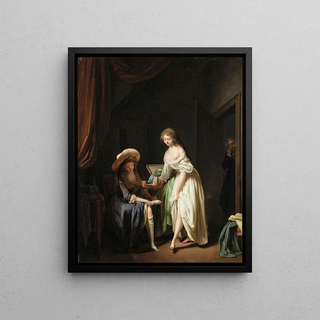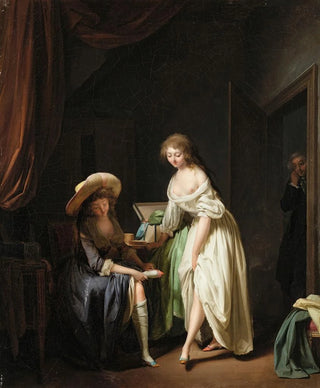Art print | Comparison of small feet - Louis Léopold Boilly


View from behind

Frame (optional)
Art print Comparison of Small Feet - Louis Léopold Boilly – Captivating Introduction
In the vibrant universe of 19th-century art, the work "Comparison of Small Feet" by Louis Léopold Boilly stands as a fascinating testament to the customs and aesthetic concerns of its time. This piece, both playful and critical, highlights the beauty standards and social conventions that governed daily life. Through this artwork, Boilly invites us to reflect on the perception of the female body, while offering a glimpse into the social interactions of his era. The scene, imbued with apparent lightness, conceals a depth that questions the viewer about beauty criteria and the judgments that stem from them.
Style and uniqueness of the work
Boilly's style is characterized by remarkable meticulousness and a keen sense of detail. "Comparison of Small Feet" is no exception to this rule. The artist excels in representing textures and nuances, managing to capture the delicacy of female feet while playing with contrasts between different sizes. The composition, skillfully orchestrated, highlights a subtle juxtaposition between shapes and proportions, thus revealing the artist's concern for visual harmony. Boilly, through his sharp gaze, freezes a scene that, although light, raises questions about society's obsession with physical beauty. This artwork, with its humor and finesse, embodies the spirit of an era where appearance was often synonymous with social status and personal value.
The artist and his influence
Louis Léopold Boilly, an emblematic figure of neoclassicism and early romanticism, managed to leave his mark on his time with his unique style and his ability to capture the essence of the customs of his era. Born at the end of the 18th century, he witnessed the evolution of French society through political and cultural upheavals. His work, rich in social observations, bears witness to a time when art did not merely aim to depict beauty but also engaged in a critique of established norms. Boilly established himself as a chronicler of his time, using painting to explore the dynamics of power and the

Matte finish

View from behind

Frame (optional)
Art print Comparison of Small Feet - Louis Léopold Boilly – Captivating Introduction
In the vibrant universe of 19th-century art, the work "Comparison of Small Feet" by Louis Léopold Boilly stands as a fascinating testament to the customs and aesthetic concerns of its time. This piece, both playful and critical, highlights the beauty standards and social conventions that governed daily life. Through this artwork, Boilly invites us to reflect on the perception of the female body, while offering a glimpse into the social interactions of his era. The scene, imbued with apparent lightness, conceals a depth that questions the viewer about beauty criteria and the judgments that stem from them.
Style and uniqueness of the work
Boilly's style is characterized by remarkable meticulousness and a keen sense of detail. "Comparison of Small Feet" is no exception to this rule. The artist excels in representing textures and nuances, managing to capture the delicacy of female feet while playing with contrasts between different sizes. The composition, skillfully orchestrated, highlights a subtle juxtaposition between shapes and proportions, thus revealing the artist's concern for visual harmony. Boilly, through his sharp gaze, freezes a scene that, although light, raises questions about society's obsession with physical beauty. This artwork, with its humor and finesse, embodies the spirit of an era where appearance was often synonymous with social status and personal value.
The artist and his influence
Louis Léopold Boilly, an emblematic figure of neoclassicism and early romanticism, managed to leave his mark on his time with his unique style and his ability to capture the essence of the customs of his era. Born at the end of the 18th century, he witnessed the evolution of French society through political and cultural upheavals. His work, rich in social observations, bears witness to a time when art did not merely aim to depict beauty but also engaged in a critique of established norms. Boilly established himself as a chronicler of his time, using painting to explore the dynamics of power and the






